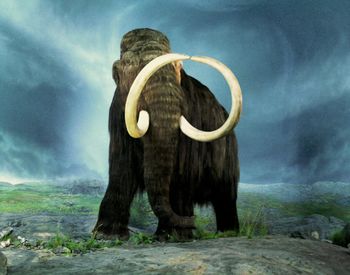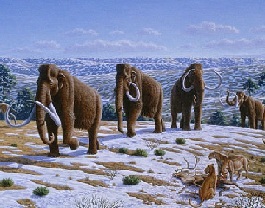Woolly mammoth
The woolly mammoth (a species of the genus Mammuthus) is a large shaggy beast that is a bit woollier than the Not-so-woolly Mammoth, and much woollier than the less common, Bald Mammoth.
These large mammals were known, from stamp indentations on their passports, to have lived all over the northernmost parts of the world, rarely leaving their home territory; however, they were thought to migrate south, at least once a year, for Mardi Gras. Further evidence suggests that they preferred to travel in small caravans, two to each mid-sized sedan in order to expedite their migration via the carpool lane.
Fossils of course[edit | edit source]
Much of what we know about the great beasts comes from fossils. Woolly mammoth fossils are commonplace in our society today. Regardless of where you live in the world, you have only to toss a small pebble in any random direction to hit a mammoth fossil[1]. Though the fossils are not worth much on their own, there is a high demand for their tusks to be used for, but not limited to, such purposes as: Back scratching implements, pike heads for impaling the unclean, and as an aid in personal stimulus.
Extinct or...[edit | edit source]
Many Scientists believe that the woolly mammoth went the way of the dodo some 10,000 years ago. When asked to speculate on what exactly happened to the woolly mammoth many theories emerged, though few were accepted.
One viable theory, put forth by a Dr. Talibut Hickenbacher, Ph.D., states that it is possible that a disease, which specifically targeted the mammoth species, wipe out the entire woolly population. This the most widely accepted belief, due to the fact that mammoths notoriously had shoddy health care[2].
Another theory, posed by one Mrs. Phillis Miller of Glasgow, postulates that there was a mass reverse migration. This migration sent the entire North American mammoth population across the Bering Land Bridge some 11,000 years ago. Signs point to the possibility of a mammoth-only kegger being held in Northern Eurasia. When the mammoths awoke the next morning the period of glaciation was over and they were stranded in Siberia. Thus they were compelled to write Russian poetry, drink vodka and, inevitably, shoot themselves in the head.
The final plausible theory came from a homeless man living under an overpass in Houston, who stated elegantly, "Shit happens". He, of course, was simply paraphrasing Murphy's Law which actually reads: "Shit happens, when it can".
Extinct?[edit | edit source]
[[File:Mammoth_italian_species.jpg|300px|right] Despite the ever-growing mountain of evidence to the contrary, there are those who believe that woolly mammoths are still out there and that they are just waiting to be found. This party consists mainly of cryptozoologists, like Randalpho Haulze, Ph.D. (?)[3], who has been chasing the elusive mammoth legend for some twenty years. A collection of his quasi-conclusive data, gathered by his crack team of scientists, was released in a series of scientific papers entitled, I saw something, but forgot my camera. The data is the foundation for two hypotheses as to where the mammoths are hiding.
Haulze's first hypothesis is that mammoths are always around us, and all of the time. He goes on to make the conjecture that they [mammoths] have just been hiding from us behind objects larger than themselves. Objects like massive boulders, ancient oak trees, large advertising billboards, and even Robert Pattinson's head.
The second of Haulze's hypotheses ingeniously infers that the mammoth is nowhere to be found because it no longer is a mammoth. Charles Darwin suggested that, over time and under certain circumstances, a species may evolve to overcome certain obstacles in its environment[4]. Taking this into account, Haulze and his team established another theory[5]; the mammoth had evolved. The woolly mammoth could very well be the modern-day Italian. "The similarities between the two species are striking" Haulze writes in his papers. Though Haulze's data is swaying he has yet to receive a research grant from The Paleontological Society of Real Scientists.


